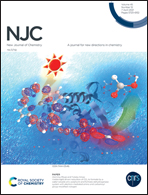A new 7-diethylamino-4-hydroxycoumarin based reversible colorimetric/fluorometric probe for sequential detection of Al3+/PPi and its potential use in biodetection and bioimaging applications†
Abstract
Herein, we have developed a new 7-diethylamino-4-hydroxycoumarin appended acylhydrazone (L) probe using a simple condensation reaction. The structure of the probe L was characterized via single crystal X-ray analysis. This probe L can selectively detect Al3+ metal ions via a colorimetric as well as fluorescence turn-on strategy over other metal ions. Besides, the probe can also detect the aluminium ions in pharmaceutical tablets. The resulting L-Al3+ ensemble has been exploited as a turn-off fluorescence sensor for the detection of pyrophosphate (PPi) anion through metal displacement or by using a decomplexation approach. Based on reversible “off–on–off” emission characteristics, the probe was applied for the construction of molecular logic gates and the development of a paper strip kit for on-site detection applications. In addition, this ensemble can also be utilized to detect PPi released during DNA synthesis and biological extracts, and in live cells.



 Please wait while we load your content...
Please wait while we load your content...